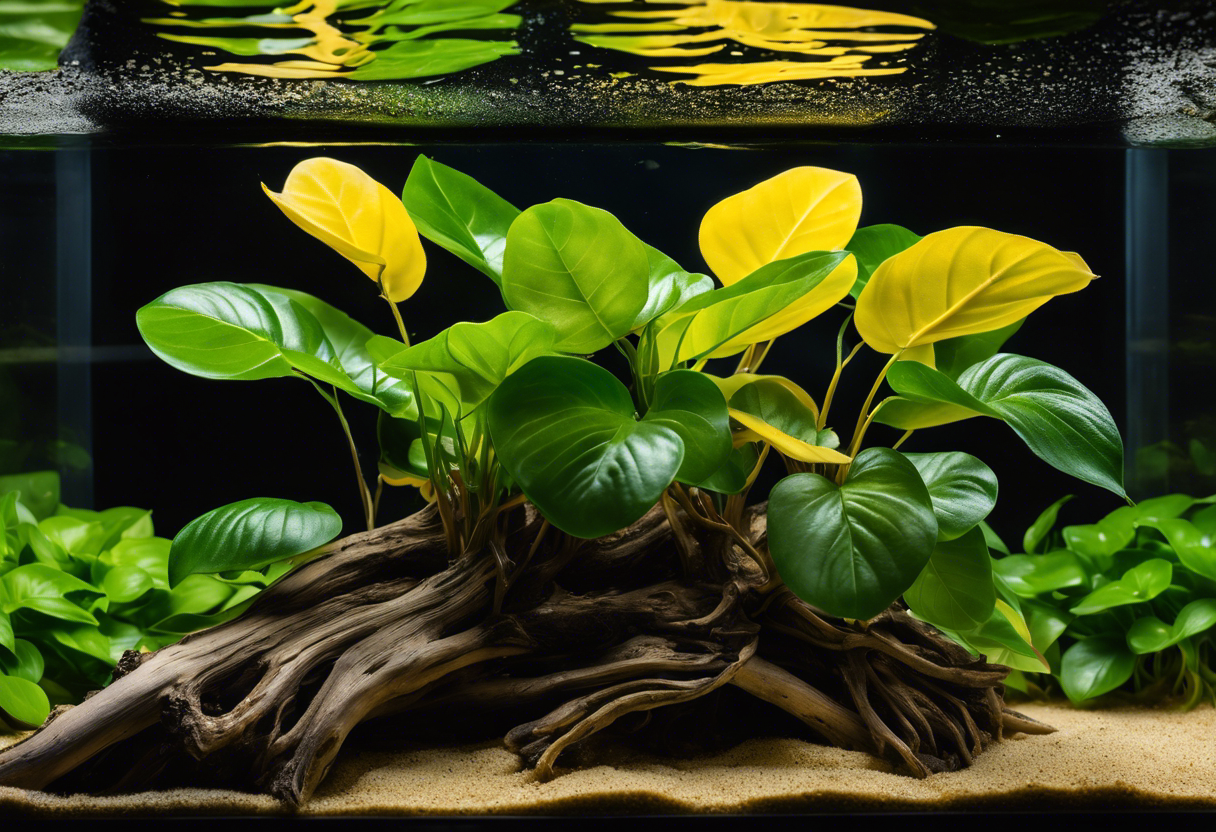Hey there, fellow plant enthusiast! Ever found yourself staring at your beloved Anubias, only to notice the leaves turning a worrying shade of yellow? You’re not alone. This is a common issue many Anubias owners face but fret not, we’ve got you covered! Anubias Leaves Turning Yellow can be a sign of various conditions that we’ll dive into in this post.
In the following sections, we’ll explore possible causes and remedies for your leafy friend’s sudden change in color. So buckle up and let’s get to solving this mystery together! Keep reading about ‘Why Are Your Anubias Leaves Turning Yellow? Solve It Today!’
Key Takeaways
- Anubias leaves turn yellow due to improper water conditions, inadequate lighting, nutrient deficiency or diseases.
- Regularly test your water for pH, temperature, and hardness. Adjust as necessary.
- Ensure your Anubias receives low to medium light. Too much light can cause leaf burn.
- Provide essential nutrients like nitrogen, phosphorus, and potassium through a balanced fertilizer.
- Treat plant diseases promptly with appropriate remedies. Regular maintenance helps prevent these issues.
Understanding Anubias Plant
The Anubias plant, a native of West Africa, is a popular choice for aquarium enthusiasts. With its lush green leaves and easy-care nature, it’s no wonder why this plant has become so beloved.
What is Anubias Plant?
The Anubias plant is a genus of aquatic and semi-aquatic flowering plants in the family Araceae. It’s named after the Egyptian god Anubis, but don’t worry – there’s nothing scary about this friendly little plant! Its broad, glossy leaves are a standout feature, giving your aquarium that tropical vibe.
Ideal Conditions for Anubias Growth
When it comes to light requirements, the Anubias plant isn’t too picky. Moderate lighting will do just fine. As for water parameters, keep it neutral or slightly acidic for happy growth. Lastly, these plants aren’t fussy about their substrate either – they’ll happily root in gravel or sand. Just remember to keep ’em wet and they’re good to go!
Identifying Yellow Leaves in Anubias
When it comes to Anubias plant care, keeping an eye out for yellow leaves on plants is crucial. It’s like playing detective with your aquatic green buddies. You see, Anubias Leaves Turning Yellow isn’t always a sign of trouble. But sometimes, it can signal some serious aquarium plant health issues or even aquatic plant diseases.
Symptoms of Yellowing Leaves
So, how do you tell if your Anubias leaf is turning yellow due to a problem? Well, the first thing you’ll notice are changes in the leaf’s color. This ain’t your typical autumnal hue shift; we’re talking about a sickly, uneven yellow that screams “Help me!”
Next up, check for other signs of unhealthy Anubias. If the yellowing is accompanied by wilting or spots on the leaves, then Houston, we have a problem! Remember folks, when it comes to diagnosing these aquarium plant issues, every little symptom counts.
Differentiating Normal and Abnormal Yellowing
Now here’s where things get tricky – distinguishing between normal aging and disease-related yellowing in Anubias leaves. You see, as part of their life cycle, Anubias leaves will naturally turn yellow and fall off. It’s just Mother Nature doing her thing.
But when this yellowing happens too often or affects younger leaves – that’s when you should start worrying. That’s not just aging; that could be a sign of an unhealthy Anubias plant. So remember folks: understanding the difference between normal vs abnormal leaf yellowing can make all the difference in maintaining healthy aquarium flora!
Causes of Yellow Leaves in Anubias
When your Anubias leaves turning yellow, it’s like a cry for help. The plant is telling you something’s not right. Let’s dive into the main culprits.
Nutrient Deficiency
Just like us humans, plants need a balanced diet too. When Anubias lack essential nutrients, they start showing nutrient deficiency symptoms in plants. You’ll notice the leaves turning pale and eventually yellow.
This is because nutrients play a crucial role in Anubias plant care. They’re vital for their overall health and growth. So, if your Anubias are looking a bit under the weather, it might be time to check their nutrient intake.
Poor Water Quality
Next up on our list of suspects is poor water quality. It’s no secret that aquarium plants thrive in clean water conditions. But when the water quality dips, so does their health.
The effects of poor water quality can be quite drastic on your Anubias. If you’ve been noticing yellowing leaves in aquarium plants, it could be due to toxins or pollutants in the water.
Remember, maintaining good water quality isn’t just about keeping your fish happy; it’s also key to preventing leaf discoloration in your aquatic plants!
Inadequate Lighting
Lastly, let’s shed some light (pun intended) on another common cause – inadequate lighting. Just like Superman needs sunlight to power up, so do your Anubias.
Insufficient light can lead to causes of leaf discoloration including yellowing leaves in Anubias. This is because light plays a vital role in photosynthesis – the process by which plants make food.
So if you’ve been keeping your aquarium lights dimmed down or off for long periods, consider this as an SOS from your Anubias!
How to Treat Yellow Leaves in Anubias
So, your Anubias leaves turning yellow is giving you a headache? No worries, we’ve got some solutions. We’re talking nutrient adjustment, water quality improvement, and light condition modification.
Adjusting Nutrient Levels
First up, let’s talk about nutrients. Your Anubias might be screaming for some essential nutrients it’s missing out on. A balanced diet is key to preventing leaf yellowing.
You see, nutrient deficiency symptoms in Anubias can often show up as yellow leaves. So, if your plant has been skipping meals or not getting the right stuff, it might just start showing those golden hues.
Improving Water Quality
Next on the list is water quality. Think of it like this: would you enjoy living in a dirty house? Probably not! Same goes for your Anubias.
Maintaining good water quality is crucial for the health of your green buddy. It’s one of the best ways to prevent leaf yellowing. If you notice signs of poor water quality in your aquarium, it’s time to roll up your sleeves and clean up!
Modifying Light Conditions
Last but definitely not least – light conditions! Just like us humans need our beauty sleep (and wake-up coffee), plants have their own light needs too.
Too much or too little light can affect the health of your Anubias and lead to those pesky yellow leaves. Finding that Goldilocks zone of just-right lighting can help keep those leaves green and glossy!
Preventive Measures for Yellow Leaves in Anubias
Prevention is the best cure, especially when it comes to Anubias plant care. It’s all about keeping those leaves green and vibrant, not yellow and sad. Let’s discuss some preventive measures that can help you avoid the dreaded Anubias Leaves Turning Yellow.
Regular Monitoring and Maintenance
Regular check-ups are like doctor visits for your Anubias. You’re looking for signs of trouble before they turn into a full-blown case of the yellows. Keep an eye out for changes in leaf color or texture.
Observation is key in aquarium plant maintenance. If you notice anything off, it might be time to adjust your care routine. Remember, prevention is always better than cure when dealing with signs of unhealthy Anubias.
Proper Feeding Practices
Feeding your Anubias isn’t just about dumping food into the tank. It’s about providing the right nutrients at the right time. Think of it as a balanced diet for your underwater green buddy.
Proper feeding habits contribute significantly to preventing yellow leaves in Anubias plants. So, don’t skimp on those essential nutrients for aquarium plants! Your Anubias will thank you with lush, green leaves instead of yellow ones.
Optimal Tank Setup
Your tank setup plays a big role in keeping your Anubias healthy and free from yellow leaves. It’s like their home – if it’s not comfortable, they’re not going to be happy (or green).
Creating an ideal environment within the tank can prevent issues like leaf yellowing in Anubias plants. So make sure your aquarium setup for Anubias is top-notch! With an optimal setup and regular maintenance, you’ll be well on your way to preventing those pesky yellow leaves.
To Wrap Up
Just like a toddler with a tummy ache, your Anubias is telling you something’s wrong when its leaves turn yellow. It might be lighting, nutrients, or temperature – the plant world’s version of too much candy! For more help, check out this discussion on Anubias Leaves Turning Yellow.
Remember, every green thumb has faced a few yellow leaves. So don’t fret, just roll up your sleeves and give your aquatic buddy the TLC it needs to thrive!





